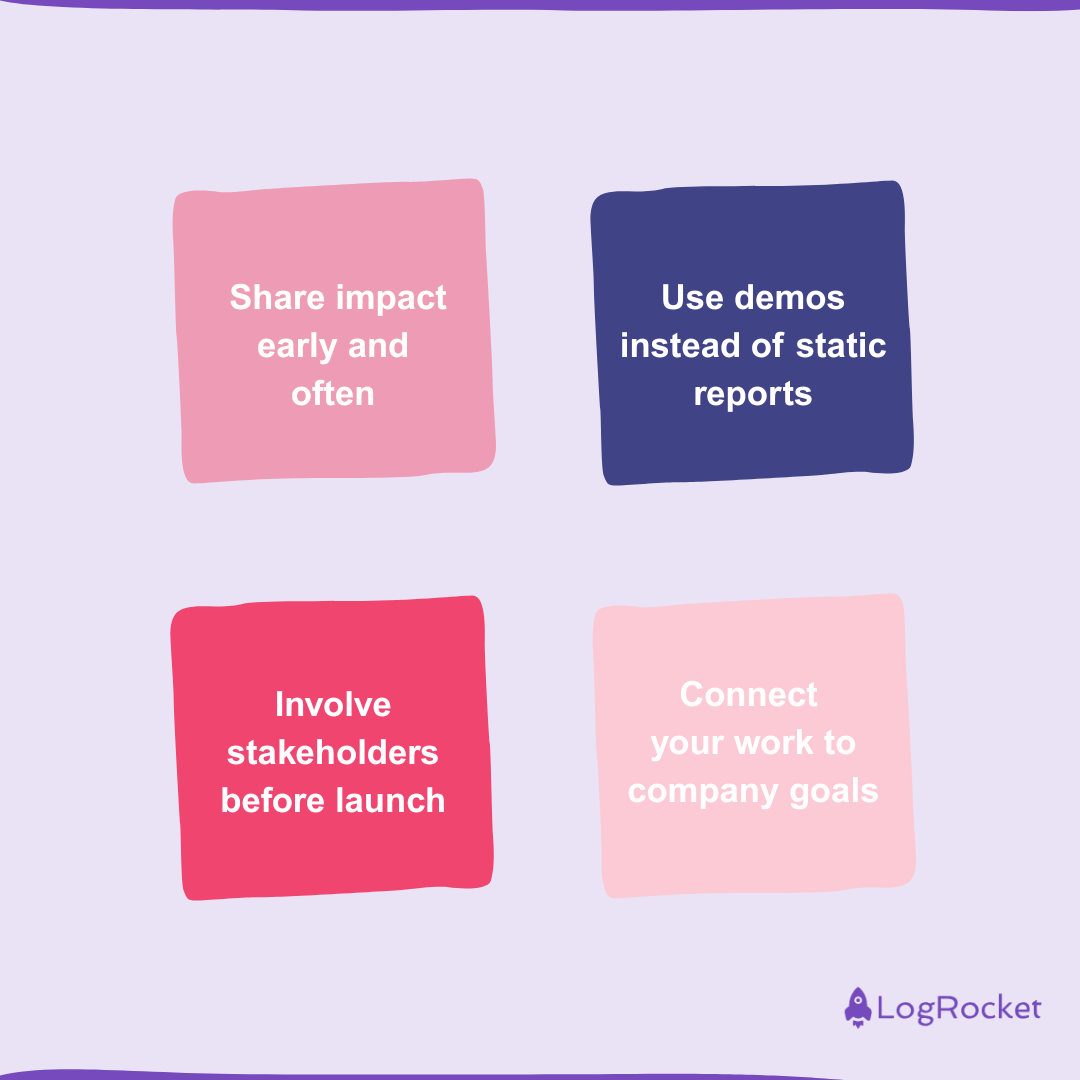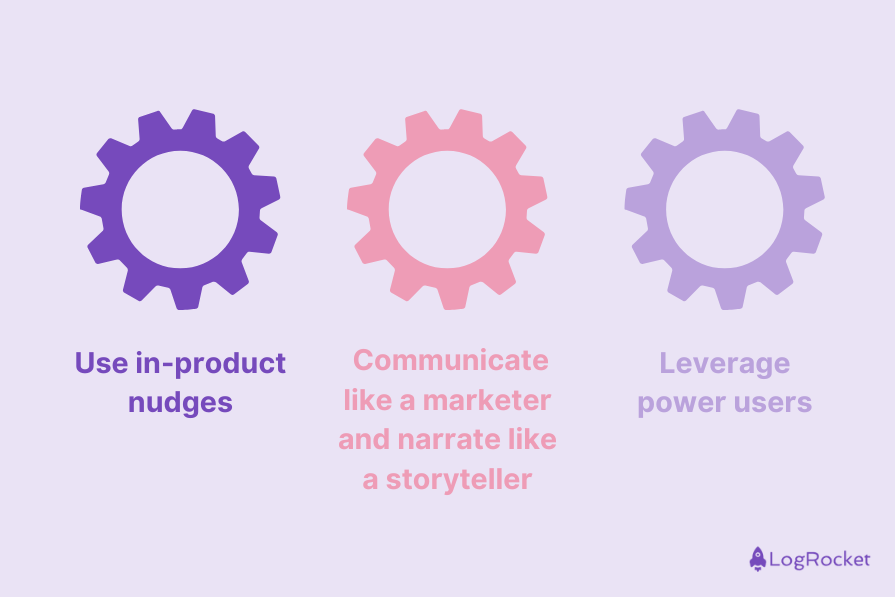Shipping alone isn’t enough: Here’s how to make your work visible
Back when I was at Zalando, I was the PM for a content management system built for 30 million daily active users. It took my team one year to build the MVP, and six months to build the first version of the product. In hindsight, it was the most complicated and high-impact product I worked on. We enabled the content production team to produce twice as much content in just one year.
But there was one problem. I wasn’t able to showcase my achievements to higher management. I talked about what we shipped, including new workflows, automation, and better publishing tools, but I didn’t connect it to outcomes leadership cared about.
I never said:
- We doubled content throughput
- We saved X hours of manual work
- We helped marketing run Y more campaigns per quarter
- We made our tool future-proof by rebuilding it with a microservice architecture
As a result, while the product was successful operationally, my work wasn’t visible at the leadership level. I was executing well but failing to translate execution into recognition.
I also got to know stories about PM’s building tools that weren’t adopted by users simply because the users weren’t aware of them.
That’s when I realized: building doesn’t equal recognition. And more importantly, as a PM, you’re not rewarded for what you build or ship. You’re rewarded for the business impact that others see you driving.
So in this blog, I want to share more about how you can build visibility around your product, your work, and your overall impact.
Internal visibility (stakeholders)
One thing I’ve learned from experience is that shipping shiny features doesn’t speak for itself. Being transparent and showing the value of your work is work in itself. This is even more important when you work for bigger companies where the company structure is more hierarchical.
At Zalando, we had 10k employees and more than 100 PMs, which means it was difficult to gain visibility from the higher management. Also, leaders and stakeholders are busy — they don’t track every Jira ticket or product review.
In the past, I have received feedback such as:
- “You’re doing good work, but I don’t fully see your impact”
- “I don’t clearly understand how this feature impacts our business”
- “The connection between the solution and the business is a little grey”
It’s easy to guess that all of these were related to the fact that I wasn’t able to make my product work visible in a way that aligns with what stakeholders care about.
The visibility pyramid
To tackle this problem, I use a simple framework called the “visibility pyramid.” It consists of the following three layers:
- Tasks (bottom layer) — “We shipped X feature.” This is where most PMs stop. It focuses on output, not impact. While useful in sprint reviews or release notes, it doesn’t communicate business value, which makes this insufficient
- Outcomes (middle layer) — “We shipped X feature, which reduced publishing time by 30 percent.” This is better as it connects the task to an actual measurable result. But the problem is, it still doesn’t connect with the business outcome
- Strategic framing (top layer) — “We reduced publishing time by 30 percent, saving 120 hours per month. This enabled marketing to run two additional campaigns per quarter, directly supporting our growth OKR.” This is where true visibility lives. It connects product outcomes to business-level goals and cross-functional success. And this is what every PM should strive for
Whether it’s operations or business stakeholders, they all think in goals and outcomes, not features or product releases. And your goal as a PM is to clearly show that. So I recommend that for your next or current product, think from the strategic side and not only the task or outcome side.
Tips to show value internally
In my experience, these four ways help you demonstrate your value to internal stakeholders:
1. Share impact early and often
Don’t wait until the end of a quarter or project. Share small wins regularly:
- “We cut campaign upload time by 30 percent, saving 120 hrs/month”
- “Our new tool enabled two extra campaigns this quarter”
Use short, clear updates via Slack or email. Leadership often notices bite-sized metrics more than long decks.
How to do it:
- Post quick Slack updates after shipping something
- Drop one-line impact notes in weekly stakeholder updates
- Add business impact in Jira tickets, Confluence pages, or wherever you save the documentation
2. Use demos instead of static reports
At Zalando, we had a bi-weekly demo within our department where every PM used to present their product progress. I used that for my teams, too. We used to end every sprint with a 10-minute live demo to the stakeholders.
Seeing the tool in action made it real and visible. A simple “before and after” demo is far more powerful than slides.
How to do it:
- Show the “before” (manual, slow)
- Show the “after” (automated, fast)
- Use real data, not mocks
3. Involve stakeholders before launch
When building a new CMS module, I invited key marketing stakeholders to beta-test features. These were the leads from the operation teams and power users. They felt ownership, gave feedback, and later became champions of our work in leadership meetings.
4. Connect your work to company goals
Before you start your project, understand the company’s goals and how they connect with your product. This’ll help you to come up with meaningful outcomes that stakeholders will buy into.
How to do it:
Before you ship, ask:
- Which OKR does this support?
- Which team benefits?
- What’s the cost saved or revenue unlocked?
External visibility (users)
Back at Zalando, we built a feature that was meant to replace a manual hack that the users had. These were internal users from Zalando. It was a clear win because the manual process was:
- Time-consuming
- Error-prone
- Widely hated
We shipped a cleaner, faster, automated version. We tested it with the user, and it indeed solved the pain point. But not all of the users used it. Primarily because of three reasons:
- We hadn’t communicated the why or made it easier to switch
- We hadn’t marketed it
- We hadn’t documented it
This was a turning point for me. It taught me that building a great feature isn’t enough. You also need to market it, embed it, and support it just like a product for external customers.
Tips to build external visibility
Here are some of my tips from my experience to build external visibility and a relationship with users:
1. Use in-product nudges
Users are busy and no one opens their inbox to read release notes. And even if they do, they rarely act on it. Your best opportunity to drive visibility is inside the product because that’s where the user is already working, making decisions, and encountering problems your feature can solve.
In-product nudges work because they’re contextual. Back at Zalando, we had a special “announcements” section that had release updates in the form of core business and user impact. This feature was widely used by the user.
How to do it well:
- Tooltips — Trigger them when a user is hovering near a relevant section
- Modals/banners — Show these once on launch, then minimize to avoid spamming
- “What’s new” sections — Let users explore updates at their own pace
- Guided walkthroughs — Highlight new features with a simple in-app tour
2. Communicate like a marketer and narrate like a storyteller
One of the biggest reasons features get ignored is that the way PMs announce them is dull and technical. Most PMs write like they’re updating a Jira ticket.
An early example of a product update from my PM journey: “v3.2.1 includes enhanced filtering logic and UI fixes.” Users don’t care about versions or internal improvements. They care about how your features help them do their job better.
Instead of saying “We added a bulk upload feature,” say, “Now you can upload all your campaign data in one go and save hours every week.” Think from the user’s perspective and rewrite your press releases.
How to do it well:
- Lead with the user’s pain point
- Explain how the feature helps them win (save time, reduce steps, earn more, etc.)
- End with a clear CTA: “Try it,” “Watch a 1-min demo,” “See what’s changed.”
3. Leverage power users
Power users are the ones who know your tools and systems inside out. They’ve been in the company long enough to know the entire ecosystem. Back at Zalando, we had three power users who were with the company for five years.
For me, these aren’t only power users but also ambassadors. Nothing builds trust and excitement like seeing power users vouch for a feature in their own words. These advocates often become your best distribution channel.
How to do it well:
- Identify power users
- Offer early access to new features
- Ask for feedback and use their quotes publicly
- Invite them to share how they’re using the feature
- Highlight their story in product updates or on social
- Ask them if you can quote their feedback and use it
Final thoughts
As PMs, we always juggle multiple responsibilities when it comes to execution. But we need to understand that visibility is as important as execution. And for this, we need to be more of a marketer and storyteller than a product manager.
I recommend going through press releases of your favorite companies (OpenAI, Lovable, Airbnb are a few of mine) and reading how each showcases its work. You’ll surely get a lot of inspiration from it. Keep users at the center, and don’t hesitate to proudly share how your product helps them. That’s how you get visibility.
Featured image source: IconScout
The post Shipping alone isn’t enough: Here’s how to make your work visible appeared first on LogRocket Blog.
This post first appeared on Read More




